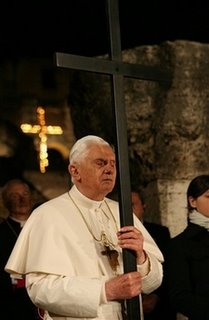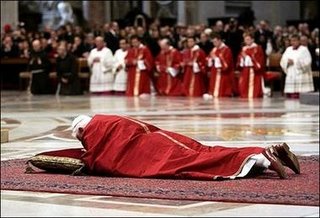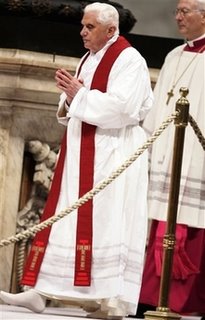
Saturday, April 7, 2007
Holy Saturday
Labels:
Dubruiel,
Joseph Dubruiel,
Michael Dubruiel,
Mike Dubruiel
Friday, April 6, 2007
A Heart of Flesh
 Following the Way of the Cross tonight, Pope Benedict remarked to the crowd:
Following the Way of the Cross tonight, Pope Benedict remarked to the crowd:"Following Jesus on the way of His Passion," the Pope said, "we see not only His passion but that of everyone who suffers in the world. This is the profound intention of the prayers of the Via Crucis - to open our hearts and help us see with the heart."
The Fathers of the Church, said the Pope,"considered that the greatest sin of the pagan world was insensitivty and hardness of heart. That is why they loved the prophet Ezekiel, who said, 'I will take away your heart of stone and give you a heart of flesh.'"
To convert to Christ, he said, meant "to receive a heart of flesh, sensitive to the passion and suffering of others." "
Our God is not a remote God, who is untouchable in His beatitude. He has a heart of flesh, He took on flesh precisely to be able to suffer with us and be with us in our sufferings. He became man to give us a heart of flesh and reawaken in us the love for the suffering and the needy."
Earlier in the day at St. Peter's Basilica the Pope began ths service prostrate:
 I could be wrong, but the carpet looks much like the one that Pope John Paul's coffin rested on at his funeral.
I could be wrong, but the carpet looks much like the one that Pope John Paul's coffin rested on at his funeral.
He held up the cross for veneration (a very good image with St. Helena in the background):
Then removed his shoes, to venerate the cross:

Labels:
Dubruiel,
Joseph Dubruiel,
Michael Dubruiel,
Mike Dubruiel
Good Friday
Labels:
Dubruiel,
Joseph Dubruiel,
Michael Dubruiel,
Mike Dubruiel
Divine Mercy Novena Begins Today
St. Faustina recounts that Jesus asked not only for a Feast of Divine Mercy, which the Servant of God, Pope John Paul II declared during his pontificate (and ironically died on two years ago on April 2nd--the Feast is movable, this year will be celebrated on April 15th), but also that Our Lord asked that a novena (nine days of prayer) to be prayed by the faithful starting on Good Friday and ending on the Feast of Divine Mercy (the Second Sunday of Easter).
I explain the history of this novena as well as include the prayers for it in The Church's Most Powerful Novenas . Thankfully, you can now search inside this book to sample not only that novena, but other unique novenas such as Mother Teresa's "express or quick novena"--when you don't have nine days to wait for an answer (like all the novenas in the book the history behind it is also included).
. Thankfully, you can now search inside this book to sample not only that novena, but other unique novenas such as Mother Teresa's "express or quick novena"--when you don't have nine days to wait for an answer (like all the novenas in the book the history behind it is also included).
The Divine Mercy Novena is a beautiful way to begin the Easter season by reflecting upon the great love that God has for us, expressed by Jesus on the cross. The prayers dictated to St. Faustina by Jesus--express His love for all of us for whom He died and reminds us that none of us, no matter how far we think we have fallen are outside of the reach of His love, forgiveness--His Mercy.
I explain the history of this novena as well as include the prayers for it in The Church's Most Powerful Novenas
The Divine Mercy Novena is a beautiful way to begin the Easter season by reflecting upon the great love that God has for us, expressed by Jesus on the cross. The prayers dictated to St. Faustina by Jesus--express His love for all of us for whom He died and reminds us that none of us, no matter how far we think we have fallen are outside of the reach of His love, forgiveness--His Mercy.
Labels:
Dubruiel,
Joseph Dubruiel,
Michael Dubruiel,
Mike Dubruiel
Way of the Cross Meditations
The full text here, but here is the tenth, Jesus is Nailed to the Cross:
MEDITATION
It was merely a rocky spur, called Golgotha in Aramaic and, in Latin, Calvary, “the Skull”, perhaps because of its physical appearance. On that peak rise three crosses, the crosses of men sentenced to death, two “criminals”, probably anti-Roman revolutionaries, and Jesus. The last hours of Christ’s earthly life begin, hours marked by the rending of his flesh, the dislocation of his bones, progressive asphyxia, interior desolation. These are hours that demonstrate the complete solidarity of the Son of God with human beings who suffer and slowly die.
A poet[33] once said: “The thief on the left and the thief on the right / felt only the nails driven into their hands. / But Christ felt the pain offered for salvation, / his side torn open, his heart run through. / It is his heart that burned. / His heart consumed by love.” Truly, all around that cross there seem to echo the words of Isaiah: “He was wounded for our transgressions, he was bruised for our iniquities; upon him was the chastisement that made us whole, and with his stripes we are healed. He makes himself an offering for sin”[34]. The outstretched arms of that mangled body want to draw to themselves the entire horizon, embracing humanity, “as a hen gathers her brood under her wings”[35]. For this was his mission: “When I am lifted up from the earth, I will draw all men to myself”[36].
* * *
Beneath that dying body files the crowd, anxious to “view” a ghastly spectacle. It is a scene of superficiality, crass curiosity, thrill-seeking. A picture in which we can also see a society like our own, which looks for stimulation and excess as if they were a kind of drug capable of arousing a sluggish soul, an unfeeling heart, a darkened mind.
Beneath that cross there is also cold hard cruelty, that of the leaders and the soldiers who in their ruthlessness are even capable of profaning suffering and death by their mockery: “If you are the King of the Jews, save yourself!” They are unaware that their words of sarcasm and the official title above the cross – “This is the King of the Jews” – are full of truth. Certainly, Jesus does not come down from the cross in a sudden dramatic turnabout: he does not desire servile obedience based on miracles, but a faith that is free, a love that is authentic. And yet, in his abject humiliation and in the very powerlessness of his death, he opens the door to glory and life, and reveals himself as the true Lord and King of history and of the world.
MEDITATION
It was merely a rocky spur, called Golgotha in Aramaic and, in Latin, Calvary, “the Skull”, perhaps because of its physical appearance. On that peak rise three crosses, the crosses of men sentenced to death, two “criminals”, probably anti-Roman revolutionaries, and Jesus. The last hours of Christ’s earthly life begin, hours marked by the rending of his flesh, the dislocation of his bones, progressive asphyxia, interior desolation. These are hours that demonstrate the complete solidarity of the Son of God with human beings who suffer and slowly die.
A poet[33] once said: “The thief on the left and the thief on the right / felt only the nails driven into their hands. / But Christ felt the pain offered for salvation, / his side torn open, his heart run through. / It is his heart that burned. / His heart consumed by love.” Truly, all around that cross there seem to echo the words of Isaiah: “He was wounded for our transgressions, he was bruised for our iniquities; upon him was the chastisement that made us whole, and with his stripes we are healed. He makes himself an offering for sin”[34]. The outstretched arms of that mangled body want to draw to themselves the entire horizon, embracing humanity, “as a hen gathers her brood under her wings”[35]. For this was his mission: “When I am lifted up from the earth, I will draw all men to myself”[36].
* * *
Beneath that dying body files the crowd, anxious to “view” a ghastly spectacle. It is a scene of superficiality, crass curiosity, thrill-seeking. A picture in which we can also see a society like our own, which looks for stimulation and excess as if they were a kind of drug capable of arousing a sluggish soul, an unfeeling heart, a darkened mind.
Beneath that cross there is also cold hard cruelty, that of the leaders and the soldiers who in their ruthlessness are even capable of profaning suffering and death by their mockery: “If you are the King of the Jews, save yourself!” They are unaware that their words of sarcasm and the official title above the cross – “This is the King of the Jews” – are full of truth. Certainly, Jesus does not come down from the cross in a sudden dramatic turnabout: he does not desire servile obedience based on miracles, but a faith that is free, a love that is authentic. And yet, in his abject humiliation and in the very powerlessness of his death, he opens the door to glory and life, and reveals himself as the true Lord and King of history and of the world.
Labels:
Dubruiel,
Joseph Dubruiel,
Michael Dubruiel,
Mike Dubruiel
New Gator Football Schedule Announced by Foley
PROPOSED FUTURE GATOR FOOTBALL SCHEDULE*
August 30, 2007 Ohio State Away
Sept 6, 2007 Ohio State Home
Sept 13, 2007 Ohio State Away
Sept 20, 2007 Ohio State Away
Sept 27, 2007 Ohio State Home
Oct 1, 2007 Off date
Oct 15, 2007 Ohio State Home
Oct 21, 2007 Ohio State Away
Nov 5, 2007 Ohio State Home
Nov 12, 2007 Ohio State Home
Nov 21, 2007 Ohio State Away
Dec 4, 2007 Ohio State Away
Dec 11, 2007 Ohio State Home
August 30, 2007 Ohio State Away
Sept 6, 2007 Ohio State Home
Sept 13, 2007 Ohio State Away
Sept 20, 2007 Ohio State Away
Sept 27, 2007 Ohio State Home
Oct 1, 2007 Off date
Oct 15, 2007 Ohio State Home
Oct 21, 2007 Ohio State Away
Nov 5, 2007 Ohio State Home
Nov 12, 2007 Ohio State Home
Nov 21, 2007 Ohio State Away
Dec 4, 2007 Ohio State Away
Dec 11, 2007 Ohio State Home
Labels:
Dubruiel,
Joseph Dubruiel,
Michael Dubruiel,
Mike Dubruiel
Thursday, April 5, 2007
Holy Thursday

From Asia News Italy:
Jesus, probably “celebrated the Passover without the lamb” , in so far as the Last Supper may have taken place before the moment in which , according to Hebrew tradition the lambs were sacrificed, and above all because He himself became the voluntary sacrificial victim, by offering His life as a gift for the salvation of mankind.
These reflections on the how and when the Last Supper took place, coupled with others on the meaning and value of the celebration, featured in the Pope’s celebration of the “In Coena Domini” Mass, which took place this evening in the basilica of St John Lateran, during which Benedict XVI carried out the rite of the washing of the feet.
Benedict XVI’s commemoration of Our Lord’s Last Supper, which opens the Easter Tridium, re-evoked the Jewish tradition of Passover, “a celebration of thanksgiving and at the same time of hope. At the centre of the memorial feast, ordered according to strict liturgical rules, was the lamb as a symbol of liberation from the slavery of Egypt”.
Yet still, “the nation suffered as a small population caught up in the tensions between great powers. Their grateful memorial of God’s intervention on their behalf in the past, transformed itself into a pleading prayer and expression of hope; come and bring to an end what you have begun! Gift us ever lasting freedom. The night before his passion Christ shared this feat of multiple meanings with his disciples. In this context we must understand the new Easter, which he gifted to us in the Blessed Sacrament”.
The theologian Pope then recalled that “In the evangelist’s accounts of this event there seems to be a contradiction between the version as told by John and those of Mathew, Mark and Luke. According to John, Christ died on the cross at the exact moment when in the temples nearby, the lambs were being slaughtered for the Pascal feast. His death coincides with the sacrifice of the lambs. That however means that he died on the eve of Passover and therefore could not personally celebrate the Pascal feast – this at least is what seems to be. According to the other three evangelists Our Lord’s last supper was a traditional Pascal feast into which he inserted the novelty of the gift of His body and blood. Until very recently this contradiction seemed irresolvable. Most of the exegetes were of the opinion that John did not want to give us the exact, historic date of Christ’s death, but had instead chose a symbolic date to highlight the one profound truth: Jesus is the true Lamb of God who shed his blood for us”.
“In the meantime the discovery of the Qumran writings has led us to a possible and convincing solution that, while not accepted by all, possesses a great degree of probability. We are now able to say that John’s account of the passion is historically precise. Christ really did shed his blood on the eve of the Passover at the hour of the slaughter of the lambs. However he celebrated Passover with his disciples according to the Qumran calendar, therefore at least one day earlier – he celebrated it without lamb, as according to the traditions of the Qumran community, which did not recognise Herod’s temple and was waiting for a new temple. Christ therefore celebrated Passover without the lamb: no, - not without the lamb: in place of the lamb he gifted his body and blood. Thus He anticipated the death with his words: “No one takes my life from me, but I lay it down on my own”. At the very moment He gives his body and blood to the disciples, He really is bringing his words to be. He himself offers His life. Only in this way does the ancient Passover obtain true meaning”.
“Thus –concluded the Pope – at the very heart of Christ’s new Easter is the cross. From the cross comes His gift to us. His body and His blood. In the blessed Eucharist, we celebrate together with the Apostles, down through the centuries, our new Easter. This gift comes from Christ’s cross”.
Labels:
Dubruiel,
Joseph Dubruiel,
Michael Dubruiel,
Mike Dubruiel
Subscribe to:
Posts (Atom)

